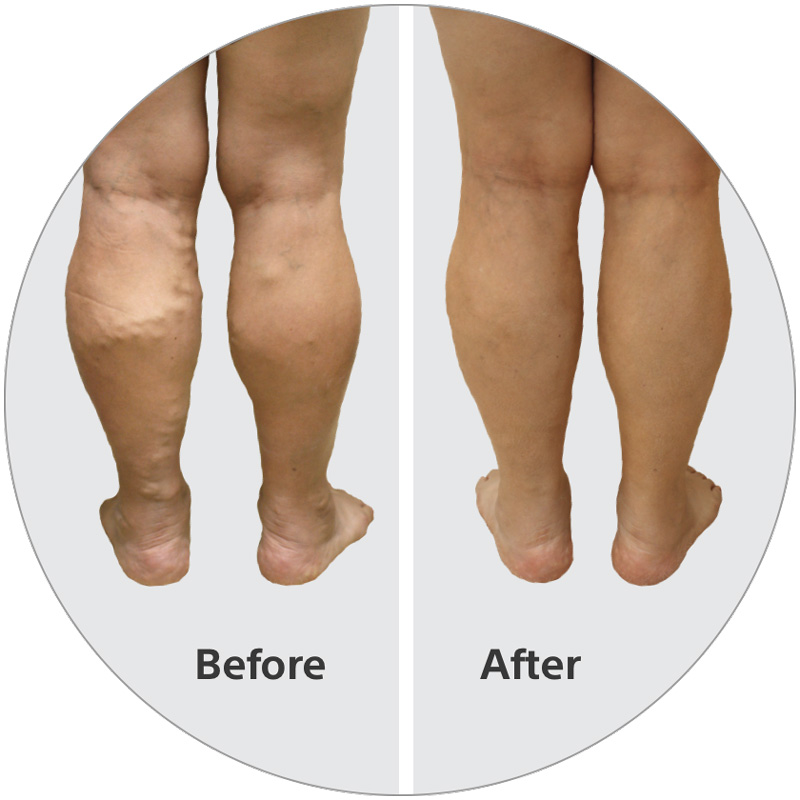Vein Disease and Education
What is the Varithena Procedure?
Varithena is a foam sclerotherapy treatment that uses a medication called polidocanol to collapse varicose veins. The foam is injected into the affected vein using a tiny needle, causing the vein wall to irritate and close up. Over time, the treated vein is reabsorbed by the body, leaving your legs looking smoother and feeling less achy.

What to Expect After the Varithena Procedure
The good news is that Varithena is an outpatient procedure, meaning you can go home the same day. You’ll likely experience some minor discomfort and bruising at the injection sites, but this should resolve within a few days.
Here’s a general timeline of what to expect after your Varithena procedure:
Immediately after: You’ll be monitored for any allergic reactions and fitted with compression stockings. These stockings will need to be worn for a few weeks to help with swelling and promote healing.
The first few days: You may experience some leg pain, itching, and bruising. You can manage these symptoms with overthe-counter pain medication and ice packs.
The first week: Avoid strenuous activity and heavy lifting. Waking is encouraged to promote blood flow.
The first few weeks: You may still have some bruising and swelling, but it should gradually improve. Continue wearing
After a few months: You should start to see significant improvement in the appearance of your varicose veins. The treated veins will eventually fade away completely.
Varithena Side Effects
While Varithena is generally safe and well-tolerated, some side effects can occur. These include.
- Injection site pain and bruising
- Allergic reactions (rare) Nerve irritation (rare) Blood clots (very rare)
It’s important to be aware of these potential side effects and to contact your doctor immediately if you experience anything severe or concerning.
Varithena Before and After
The results of Varithena can vary depending on the severity of your varicose veins. However, most people see significant improvement within a few months. You can expect the treated veins to fade away, leaving your legs looking smoother and feeling less achy.

Pros and Cons of Varithena
Pros:
- Minimally invasive
- No incisions or scars
- Relatively quick recovery time
- Effective for treating a variety of varicose veins
- Covered by most insurance plans
Cons:
- May require multiple treatments
- Not suitable for all patients
- Potential side effects Can be expensive
Varithena vs. Other Varicose Vein Treatment Options
There are several other options available for treating varicose veins, each with its own advantages and disadvantages.
Some common alternatives include:
- Laser ablation: This minimally invasive procedure uses laser energy to heat and destroy the varicose vein.
- Sclerotherapy: This involves injecting a solution into the vein to irritate and collapse it.
- Phlebeqtomy: This is a surgical procedure that removes the varicose vein through small incisions.
The best treatment option for you will depend on the severity of your varicose veins, your overall health, and your preferences.
The purpose of leg veins is to carry blood from the legs to the heart. When you walk, the calf muscle contracts, and pushes the blood up towards the heart, and then a network of valves in the veins, prevents the blood from going backwards towards the foot. This is specifically important when you are standing up or walking.
When the veins have valves that are no longer able to work adequately, blood can travel towards the foot and the ankle when you stand up or walk. This is called venous reflux. That causes pressure on the veins, that causes small veins to expand and become large (varicose), and exerts undue pressure on the ankle area which then becomes swollen , painful, and can get red, scarred, or sometimes breaks down into ulcers.
The venous system is divided into 2 sets of veins. The superficial system is everything that is outside the muscle but it is visible from the surface or not. The deep system is everything that is inside the muscle.
The superficial system is redundant, and that means that it has excess veins that can take over for many veins that are shutdown or removed.
The deep system is non-redundant meaning that one cannot sacrifice any portion of that system even if those veins are not working very well.
The vein diagnostic ultrasound looks at the direction of flow in both the deep and superficial systems.
If there is reflux (that means flow towards the foot and away from the heart which is the wrong direction) in the superficial system, then those veins that are affected can be ablated by using either heat, or glue, or chemicals.
If there is reflux in the deep system, the only treatment is to wear compression stockings.
Regardless of the treatment modality that is chosen to shutdown refluxing veins, there is always the risk of having a clot form in the deep system which would then require being on blood thinners. This only happens in the 1 to 5% of people, and we take significant precautions to avoid that happening, but unfortunately this cannot be avoided completely.
In the majority of patients with vein disease, wearing compression stockings is helpful in the long run to prevent the progression of disease and controlling the amount of pressure on the calf, ankle, and feet.
Compression stockings can be worn when standing up or walking, and do not seem to be worn at night or when the legs are elevated. Even wearing stockings part-time as opposed to every day is still helpful as it reduces the duration that the legs are exposed to the negative effects of high pressure from the venous system. Obviously, the more regularly they are worn the better the benefit to the patient.
